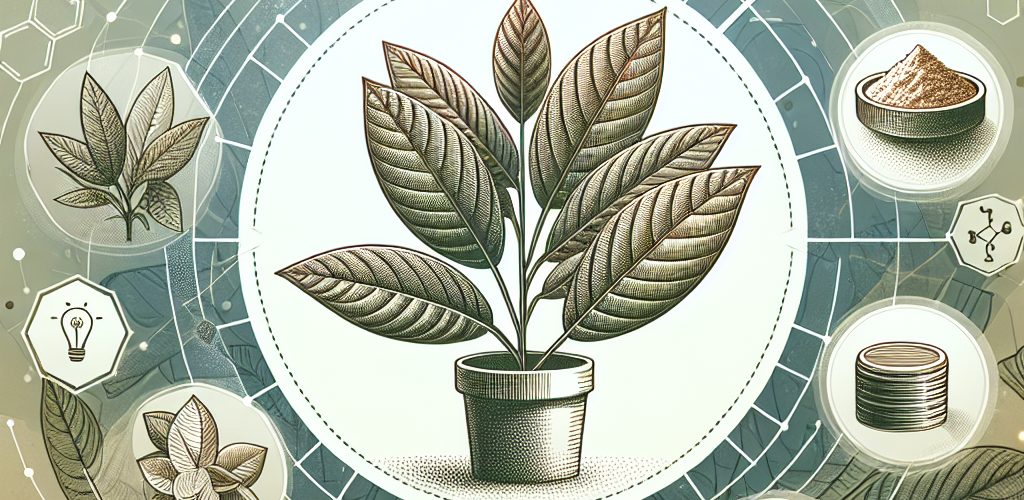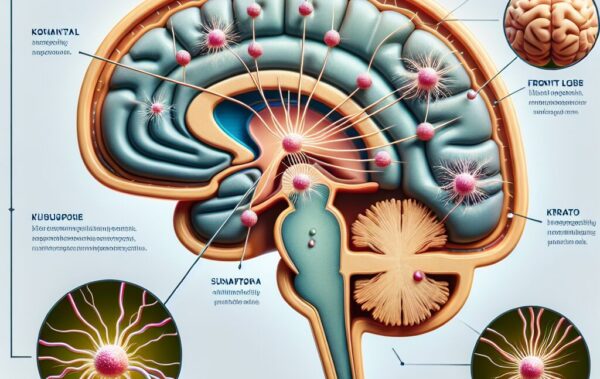- Understanding Kratom and Its Alkaloid Profile
- Kratom’s Mechanisms in Chronic Pain Management
- Comparative Analysis of Kratom and Traditional Painkillers
- Safety Considerations and Responsible Use of Kratom
- Frequently Asked Questions About Kratom Use for Pain Relief
Kratom, a tropical evergreen tree from Southeast Asia, has garnered significant attention for its potential in chronic pain relief. The plant’s leaves contain a complex alkaloid profile that is responsible for its diverse pharmacological effects. Among these alkaloids, mitragynine and 7-hydroxymitragynine are of particular interest due to their prominent roles in pain management.
The alkaloids in kratom work on the body’s opioid receptors, but they do so in a way that is uniquely different from traditional opioids. This interaction is at the heart of kratom’s analgesic properties, offering relief to those suffering from chronic pain. Unlike opioids, which can lead to significant dependence and a host of adverse effects, kratom’s alkaloids exert a more subtle influence on the opioid receptors, which may reduce the potential for dependence and side effects.
Despite the promise it holds, kratom use is not without controversy. The variation in alkaloid content based on different strains and harvesting methods means that the effects of kratom can vary greatly from one batch to another. However, many users have reported significant chronic pain relief after consuming kratom, lending anecdotal weight to the growing body of research exploring its potential benefits.
For those interested in exploring the various kratom products available, it is important to choose reputable sources that provide high-quality, consistent strains. As such, online marketplaces like the Kratom shop page and specific categories like Kratom powder or Kratom capsules can be a starting point for those seeking to manage their pain with this herbal alternative.
By understanding kratom and its alkaloid profile, individuals can make more informed decisions about incorporating this natural substance into their pain management regimen. Those who consider trying kratom for chronic pain relief should do so with an awareness of the correct dosages and potential effects, bearing in mind the importance of quality and consistency in the products they choose.
Kratom’s Mechanisms in Chronic Pain Management
When diving deeper into kratom’s mechanisms for chronic pain management, it becomes clear that this natural substance encompasses both promise and complexity. Kratom and its key alkaloids interact with the body’s opioid receptors to provide pain relief. This process is often compared to the way natural painkillers work, yet kratom maintains a distinct profile.
Molecularly, mitragynine, the primary alkaloid in kratom, is structurally different from classical opioids. This difference is crucial in how it affects the user. Rather than fully activating opioid receptors, mitragynine is considered a partial agonist, which may contribute to a lower risk of dependence and addiction. Moreover, it also acts on other neurotransmitter systems, including adrenergic and serotonergic pathways, adding to its analgesic effects.
Here’s a clearer breakdown of how kratom functions in the body:
- Opioid Receptors: Mitragynine primarily acts on mu-opioid receptors, providing pain relief while avoiding the full-fledged activation that is typical with traditional opioids. This can result in fewer euphoric effects and less respiratory depression, a serious risk associated with opioids.
- Adrenergic System: Kratom also targets the adrenergic system, potentially reducing pain through adrenergic pathways, which could lead to increased energy and alertness rather than sedation.
- Serotonergic Actions: Its interaction with serotonergic receptors may contribute to mood enhancement, an effect that may further help those dealing with chronic pain, for whom depression and anxiety often accompany physical ailments.
The natural pain relief facilitated by kratom’s complex actions on various systems can mean chronic pain sufferers find a degree of relief not typically afforded by conventional painkillers. However, the varying effects from different kratom strains should be considered. Some strains may be more energizing, while others offer a more sedating effect, which can impact the type of pain relief experienced by the user.
| Kratom Strain | Reported Effects |
|---|---|
| Red Vein | Sedating, stronger pain relief |
| White Vein | Energizing, mild pain relief |
| Green Vein | Balanced energy and pain relief |
As we compare kratom to traditional painkillers, one cannot help but notice the unique attributes of this herbal pain management tool. It’s the multi-faceted approach that seems to provide chronic pain relief while diminishing the likelihood of serious side effects. Furthermore, the fact that many people report satisfactory pain management with kratom indicates that its therapeutic potential lies in its natural ability to address pain in multiple ways.
The holistic approach kratom takes in managing pain sets it apart from traditional pain medication, which often focuses on a singular pathway or mechanism. Kratom benefits come with the promise of a less invasive side effect profile and a natural method to manage discomfort. It’s an attractive option for those looking for alternatives to pharmacological painkillers, especially at a time when the opioid crisis has highlighted the need for safer, more responsible pain management solutions.
In summary, the chronic pain relief afforded by kratom could be a game-changer for individuals dealing with ongoing pain. The key is to approach kratom use with an understanding of the intricate mechanisms at play. While kratom might open doors to pain management that weren’t previously considered, users must still employ caution, paying close attention to dosing, strain selection, and quality from trusted suppliers such as those found on Kratom Markets.
Comparative Analysis of Kratom and Traditional Painkillers
The comparative analysis of kratom and traditional painkillers draws interest from both the public and the medical community, as individuals seek effective and safe ways to manage their chronic pain. On the one hand, you have kratom, a natural botanical with a long history of use in traditional medicine in Southeast Asia. On the other, there are traditional painkillers—often pharmaceutical products—that have been the bedrock of pain management in Western medicine for decades.
Traditional opioids, such as morphine, oxycodone, and hydrocodone, are notorious for their risk of dependence and addiction, as well as their potentially dangerous side effects, including respiratory depression. These natural painkillers act by fully activating the opioid receptors in the brain, which can result in a strong sense of euphoria, contributing to their potential for misuse. While effective in alleviating pain, the consequences of long-term opioid use can be devastating, leading to a plethora of health, social, and economic issues.
In contrast, the alkaloids in kratom, primarily mitragynine, employ a distinct action mechanism. By partially agonizing the opioid receptors, kratom can provide chronic pain relief without leading to the significant euphoria or respiratory depression typically associated with opioids. This unique attribute of kratom benefits those who wish to avoid the risks traditional opioids present. Moreover, the herbal pain management provided by kratom comes with additional psychoactive properties, which may uplift mood and reduce symptoms of anxiety—common comorbidities in chronic pain sufferers.
Let’s delve deeper into a side-by-side comparison:
| Kratom | Traditional Painkillers |
|---|---|
| Potentially less addictive | Higher risk of addiction and dependence |
| Partial opioid receptor activation | Full opioid receptor activation |
| Varied strain effects | More predictable pharmacologic profile |
| Mood enhancement properties | Primarily pain relief, risk of mood depression |
| Minimal respiratory depression | Significant risk of respiratory depression |
It’s important to highlight that the benefits of kratom don’t stem from a single mechanism of action but from a symphony of its interactions within the body. Consumers can select from a variety of kratom strains, each with its unique balance of alkaloids, to target specific types of pain and desired effects, whether that’s sedation, stimulation, or a balance of both.
However, no discussion about kratom as a natural alternative to traditional painkillers would be complete without addressing the concerns surrounding its quality and regulatory status. While the FDA has not approved kratom for medical use, many users anecdotally report significant improvement in their quality of life due to the chronic pain relief they experience with kratom. It is paramount for users to obtain kratom from reputable sources, ensuring the product’s purity, consistency, and safety—elements that are fundamental when considering herbal pain management approaches. Venues like Kratom Markets play a critical role in providing access to such quality kratom products.
Ultimately, the choice between kratom and traditional painkillers should be made with full consideration of the individual’s pain management needs, medical history, and potential risks. As with all pain management strategies, a healthcare professional should be consulted before initiating any new treatment, be it with kratom or traditional pharmaceuticals. Responsible use, informed decision-making, and an emphasis on safety are key to maximizing the benefits while minimizing the risks in chronic pain management.
Safety Considerations and Responsible Use of Kratom
 As we delve into the nuances of safe kratom use, it’s crucial to consider the responsible approaches and precautions necessary to maximize the potential kratom benefits while minimizing any risks. For those who are turning to kratom for chronic pain relief, the following considerations should be front and center:
As we delve into the nuances of safe kratom use, it’s crucial to consider the responsible approaches and precautions necessary to maximize the potential kratom benefits while minimizing any risks. For those who are turning to kratom for chronic pain relief, the following considerations should be front and center:
Quality and sourcing are paramount when selecting kratom. Since kratom is not regulated by the FDA, the market can be a minefield of inconsistent product quality. It’s essential to choose vendors with a strong reputation for purity and safety. Reliable suppliers, such as those featured on the Kratom Markets platform, typically conduct third-party testing to verify the alkaloid content and ensure the absence of contaminants, such as pesticides and heavy metals.
Dosage is another crucial factor when using kratom for pain relief. Because of the variability among strains and individual responses, starting with a lower dose is advisable, gradually increasing as needed to achieve the desired effects. Overuse can lead to tolerance, dependence, and unwanted side effects, so mindfulness in dosing is a must. For those new to kratom, products like kratom capsules can simplify the dosing process due to their pre-measured contents, making responsible usage more manageable.
Education about the different strains and their effects is also important in ensuring responsible use. Strains vary in their alkaloid composition and consequently, their effects. For example, red vein strains tend to provide more potent pain relief and are more sedating, making them suitable for evening use. Contrastingly, white vein strains may offer milder pain relief with a boost in energy, better suited for daytime activities. Consumers can find various strains with a click, visiting marketplaces like Kratom powder category to explore and choose the one that best suits their needs.
The potential for drug interactions must not be overlooked. Kratom may interact with other medications or substances, potentially leading to adverse effects. It is strongly recommended to consult healthcare professionals before incorporating kratom into an herbal pain management regimen, especially if other medications are currently being used.
Recognizing the signs of misuse and dependence is an essential aspect of responsible kratom use. While kratom is often hailed as a natural painkiller with a lower potential for addiction, it is not without risk. Users should be vigilant in monitoring their consumption patterns and the effects experienced. Taking regular breaks from kratom use can help prevent developing a tolerance and dependence.
Below are some key pointers for ensuring safety and responsible use:
- Always source high-quality kratom from credible vendors.
- Begin with a low dosage and adjust gradually as needed.
- Educate yourself on the different kratom strains and their effects.
- Consult a healthcare professional to discuss potential interactions with other medications.
- Be cognizant of consumption patterns to avoid misuse and dependence.
Leading a responsible lifestyle while using kratom for chronic pain relief also means staying informed about the evolving legal status and recommendations surrounding the substance. As research continues and regulatory perspectives shift, staying up-to-date on the latest information can guide safe usage practices and better decision-making around kratom consumption.
To summarize, kratom presents itself as a promising herbal pain management alternative with an array of potential benefits when used sensibly and safely. As the chronic pain relief brought about by kratom continues to aid numerous individuals, it’s the combination of due diligence, proper education, and sound judgment that will help ensure that the natural painkillers like kratom remain a viable option for managing discomfort in an effective and responsible manner.
Frequently Asked Questions About Kratom Use for Pain Relief
When considering kratom for chronic pain relief, individuals often have questions about its use, effectiveness, and safety. Kratom has emerged as a natural painkiller with a variety of strains and forms, suitable for different needs and preferences. Its use in herbal pain management is gaining traction, but with such a novel remedy, inquiries are bound to arise. Here we address some of the most commonly asked questions to help users better understand kratom’s role in chronic pain relief.
How does kratom compare to conventional pain medications when it comes to chronic pain relief?
While conventional pain medications, especially opioids, are effective for pain relief, they come with significant risks of addiction and adverse effects. Kratom benefits those seeking a natural alternative by offering pain relief with a lower risk of severe side effects. Users often report effective management of their pain with less sedation and dependency concerns.
Is kratom legal to purchase and use for pain management?
The legality of kratom varies worldwide and even between states in the U.S. Before purchasing and using it for chronic pain relief, it’s essential to check the current legal status in your area. As of my knowledge cutoff in 2023, kratom is federally legal in the United States but banned in certain states and cities.
What strains of kratom are best for managing pain?
Typically, red vein kratom strains are considered the best for pain relief because of their potent analgesic properties and sedative effects, making them ideal for evening use. Green vein strains offer a balance between pain relief and energy, while white vein strains are less sedative and can be more energizing. It is crucial to select a strain that aligns with your specific pain management needs and lifestyle requirements.
How do I start using kratom for pain relief?
Begin with a low dose to gauge your body’s reaction, and incrementally increase the dosage if necessary. Considering the various available forms, you might start with kratom capsules for controlled dosages or experiment with powdered kratom for adjustable serving sizes. Consulting with a healthcare professional before starting any new pain management regimen, including kratom, is always a wise decision.
Are there any side effects to using kratom for pain management?
As with any substance, kratom may have side effects, which can include nausea, constipation, or dizziness, particularly at higher dosages. The risk of side effects can be mitigated by starting with low doses and increasing gradually, as needed. Long-term use at high doses could lead to dependence, so it’s important to use kratom responsibly.
Can I use kratom in conjunction with other pain management methods?
It is essential to consult with a healthcare provider before combining kratom with other pain management methods, including prescription medications, over-the-counter drugs, or other herbal remedies. There are potential interactions that need to be considered to avoid adverse effects.
In conclusion, while kratom offers an appealing option for natural pain relief, it’s vital to approach its use thoughtfully and cautiously. Responsible use, backed by credible information and healthcare advice, is key in harnessing kratom benefits for chronic pain relief. For those interested in exploring high-quality kratom products, the Kratom Markets online marketplace offers a diverse range of options to consider.









